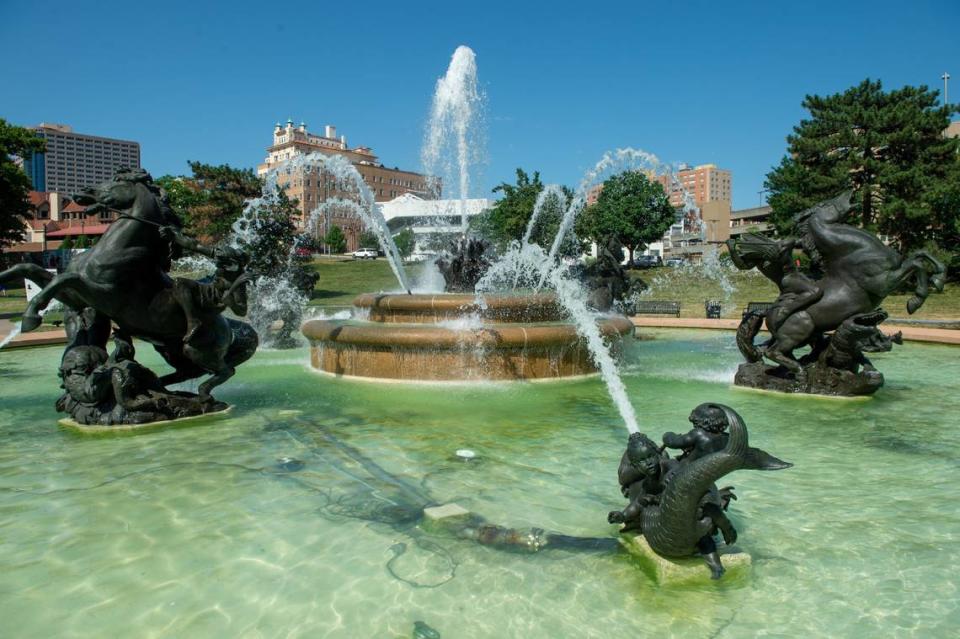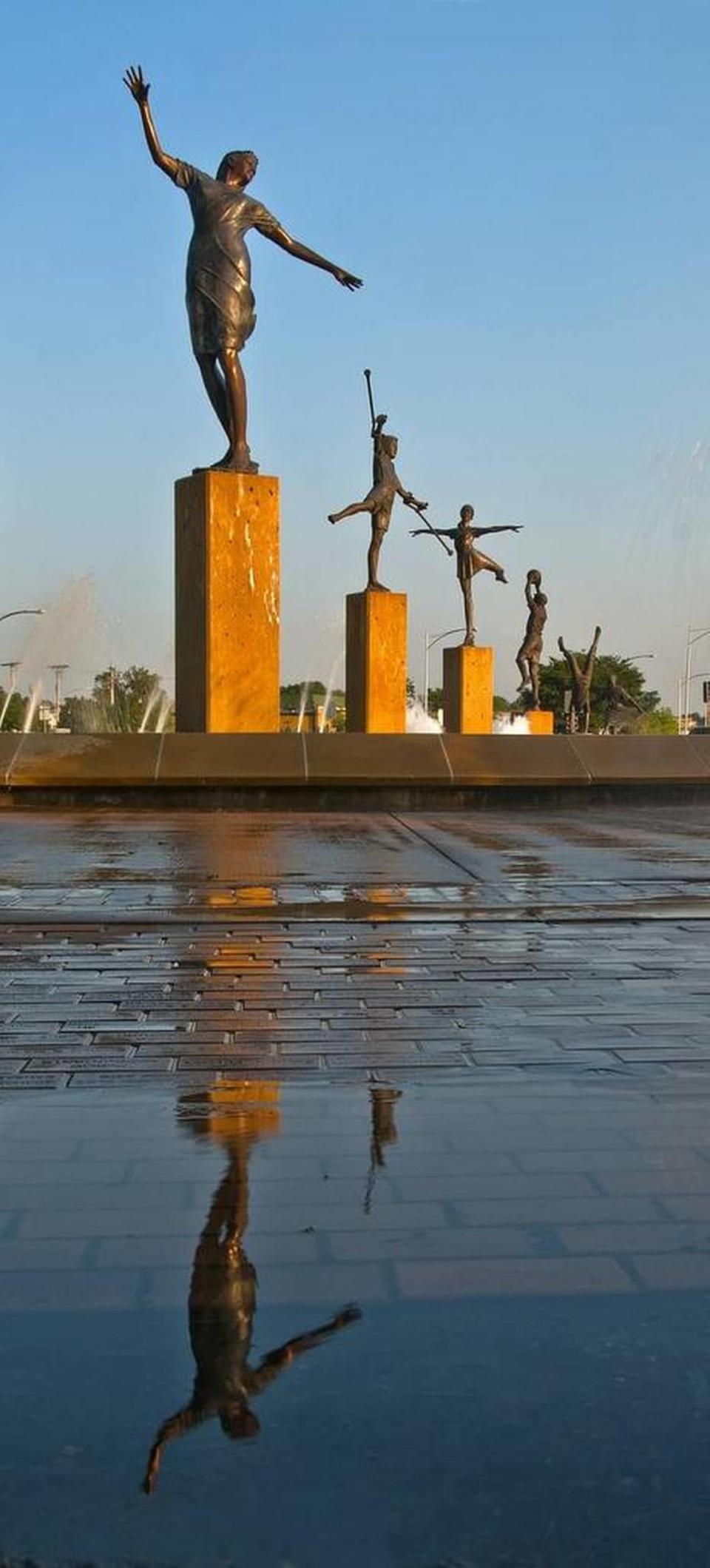Kansas City makes dubious claims about its fountains. Here’s why I go with the flow
Your Guide to KC: Star sports columnist Vahe Gregorian is changing uniforms this spring and summer, acting as a tour guide of sorts to some well-known and hidden gems of Kansas City. Send your ideas to vgregorian@kcstar.com.
Any time I take an out-of-town friend around Kansas City, the words reflexively blurt out of my mouth:
You know, they say we have more fountains than any place but Rome.
Then I instantly turn skeptical and apologetic, because of course that seems preposterous … and why am I even bringing it up if I don’t know?
So when I embarked on this temporary gig to write about “Uniquely KC” matters, it seemed a fine time to address this. And then I almost immediately happened upon the 51st annual Fountain Day ceremony that marks the flipping of the seasonal water switch of Kansas City’s approximately 40 fountains among some 200 in the region.
On a blustery day at the Northland Fountain in Anita B. Gorman Park, Mark McHenry, president of the City of Fountains Foundation, compared it to the start of baseball as “a ritual of spring.”
And, hey, a really nice one.
When I asked McHenry about the “most fountains” claim, he promptly asked if I’d ever been to Rome.
Just last summer, as it happens.
“So how many fountains were working?” he said.
Well, not so many.
“That’s our story! …” he said. “We have more working fountains than Rome.”
With a smile, he added, “Now, you can challenge me on that if you want to.”
He quickly beat me to my quibble and agreed that Rome’s fountain history has more grandeur. The city still has some 300 monumental fountains, thousands overall, many centuries old.
But there’s a bigger, better point than whatever the numbers might say about our “City of Fountains” brand.
It’s a tapestry that tracks from where we came — fountains here largely first were used with horse troughs — to our ever-flowing city today that never stands still.
And it didn’t just unfold, presto, the way you might think.
‘A sad tale of failure’
The wave of Kansas City’s future began with an inauspicious gurgle.
In 1892, George Kessler, the renowned city planner, was hired to design a boulevard and park system plan that would provide for a “city within a park,” as Kansas City Parks & Recreation puts it.
He aimed to change what he and KC Park Board president August Meyer observed in an 1893 report as a place that had made “no public concession to esthetic considerations.” Kessler commissioned Kansas City’s first purely aesthetic fountain in the midst of his preeminent boulevard: The Paseo.
Alas, “The Fountain,” the monument modeled after the Latona Fountain of Versailles, France, was bedeviled from nearly the instant it was activated on June 14, 1899.
For starters, the water shot so high in the sky that it conspired with winds to douse passersby. That and other structural issues led The Star to write in 1908 that the park board had stopped trying to provide water for its “white elephant to drink. It was a sad tale of failure.”
Meanwhile, in the 1890s, the city added drinking fountains for its “overtaxed” horses, The Star wrote. Within a few years, finding a fountain shut down because the water was spreading disease, an official with the National Humane Alliance proclaimed, “I am thoroughly disgusted with Kansas City.”
Not exactly a portent of the future.
So we didn’t really start going with the flow until the 1920s with J.C. Nichols’ incorporation of fountains into the scheme of the Country Club Plaza. While Nichols’ racist redlining (boosted by Star founder William Rockhill Nelson) led to his name being stripped away from the adjacent fountain that is Kansas City’s most grand and recognized, we’re still left to reconcile the fact that this distinguishing flourish of ours is part of his legacy.

‘I did hire at one time a fountain counter’
Elusive in its own way, meanwhile, is whether we do or don’t have more fountains than anywhere but Rome.
It’s hard to know, though, even the basic basis: exactly when we even began calling ourselves the City of Fountains.
Even Ellen J. Ugoccioni and Sherry Piland, the learned and dedicated authors of the 1986 book “Fountains of Kansas City: A History and Love Affair,” told The Star then that they never sorted out who initiated the City of Fountains nickname.
It’s also evident that any major effort to link ourselves to Rome didn’t begin in earnest until the 1970s.
Then-Hallmark executive Harold Rice and his wife, Peggy, visited Rome in 1973 and soon formed the City of Fountains Foundation. In an editorial a year later, The Star wrote, “If Rice has his way, in time Kansas City could become the Rome of the Middle West.”
Around then, the Greater Kansas City Chamber of Commerce and several local businesses underwrote a booster campaign called “Prime Time.” Part of it included a television commercial depicting scenic views of the city and narrated by actor Barry Sullivan, a pitch resurrected verbatim by The Star’s Mike Hendricks in 2000:
“There’s a city with more public green space than San Francisco — including the second-largest urban park in America — with more fountains than any place but Rome, more boulevard miles than Paris and cleaner air than Honolulu.
“Kansas City: One of the few livable cities left.”
Hendricks tracked down Texas advertising man Larry Lubenow (who died in 2014) as the originator of the perhaps tall tales.
And didn’t quite get a scientific answer.
“I did hire at one time a fountain counter, a young intern,” Lubenow said then — albeit acknowledging he wasn’t sure, say, if the intern had counted the water spectacular at Kauffman Stadium by each spray or as one fountain.
As for where we stand today?
Well, who knows, really?
Like many websites, WorldAtlas.com says we are indeed second to Rome … but it’s uncited and unclear how it comes to that conclusion. Also uncertain is how many ancient cities feel incentivized to audit their case.
In a 2006 piece called “Believe It Or Not! True or False?” about various Missouri legends, Missouri Life magazine wrote that it found “no substantiation of any other city that might have fountains numbering in between Rome’s and Kansas City’s” … but still felt the need to call it “a beautiful urban legend.”
That thought resonates with me, whatever the data might say. I can’t say I know much about art, but I believe part of its essence is that it can’t be quantified any more than we can definitively say only Rome has more fountains than we do.
All we really know, and all we really need to know, is that our fountains became a vibrant force enmeshed with who we are.
While that bit about “more working fountains” than Rome probably doesn’t hold water, well, it’s also why the City of Fountains Foundation needs you to help maintain and conserve our version of the City of Fountains.
“We don’t want to lose the title, right?” McHenry said, smiling.
Never mind that all we know for sure is that it’s been self-proclaimed into existence.

My three favorite KC fountains
Every Kansas City-area fountain is a rich story unto itself. Here are three that resonate with me:
▪ The Children’s Fountain (North Oak and 32nd Avenue): Based on children from his neighborhood, according to the City of Fountains Foundation, sculptor Tom Corbin created six 8- to 9-feet tall figures to represent children everywhere: “Joy posing happily on one pedestal; Meeting Challenges represented by a boy with crutches; a ballerina; a boy playing soccer; a boy standing on his head and a girl wading into the pool of the fountain.”
▪ Vietnam Veterans Memorial Fountain (Broadway and 42nd): Here’s how Kansas City Parks & Rec describes this fountain designed by David M. Baker: “five rectangular, inter-connected pools of different sizes … (that) represent growing American involvement in the war. The water flows into two separate pools, symbolizing the division of American opinion of the country’s involvement in the war … (and) is symbolic of time with the power to cleanse and heal the divisions the Vietnam War caused.”
A semi-circular memorial wall features the names of the 451 war casualties from the Kansas City area.
▪ Henry Wollman Bloch Fountain (30 W. Pershing Road): This gift to the city in the name of the H&R Block co-founder was fashioned by WET Design, whose work includes the fountains at the Bellagio in Las Vegas. The sheen of water over flat granite, as described by the City of Fountains Foundation, “creates a large mirror to reflect the historical and monumental architecture on either side of the fountain.”
Namely, Union Station and the National WWI Museum and Memorial.
Also: It was a great place for Royals fans to drench in the moment celebrating the 2015 World Series with the ceremony at Union Station.
What’s your favorite Kansas City area fountain? Email me at vgregorian@kcstar.com.

